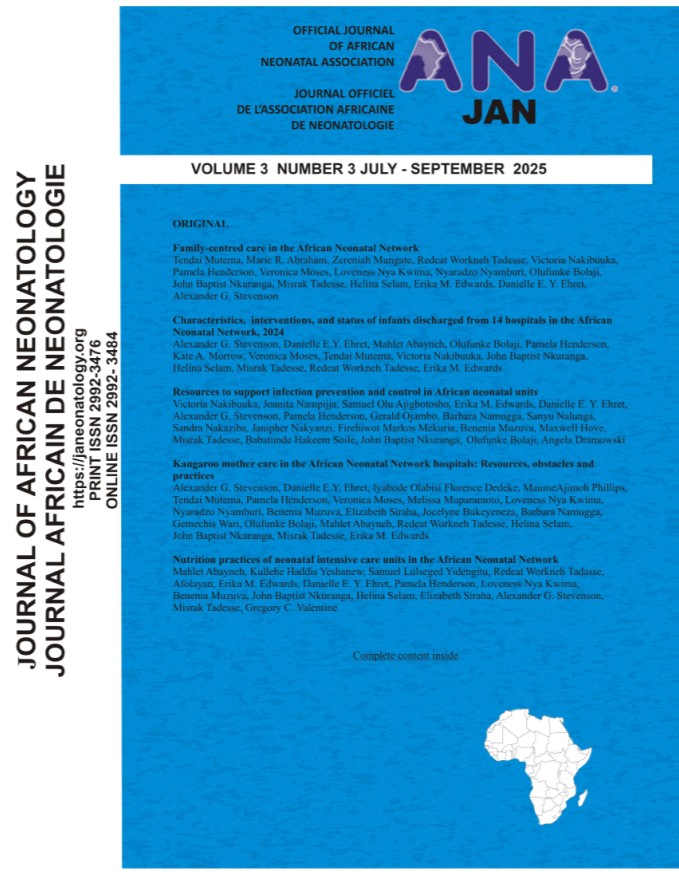Kangaroo mother care in the African Neonatal Network hospitals: Resources, obstacles and practices
Keywords:
Infant, Newborn; Premature; Infant Mortality / prevention & control; Kangaroo-Mother Care Method; Skin-to-Skin Contact; Neonatal Intensive Care Unit;Abstract
Background: Kangaroo mother care (KMC) is a proven, low-cost intervention that improves survival and outcomes for preterm infants. However, its uptake remains suboptimal, and data on KMC implementation across African hospitals are limited.
Objective: To document the current resources and practices related to KMC provision in hospitals within the African Neonatal Network.
Methods: Fourteen hospitals in the African Neonatal Network responded to an annual facility survey and a health facility survey co
-developed by faculty in the African Neonatal Network and Vermont Oxford Network. Additionally, a point-prevalence audit was conducted to evaluate KMC provision for all eligible preterm infants on a single day. All analyses use descriptive statistics.
Results: Only one hospital had a fully operational immediate kangaroo mother care (iKMC) unit, though four others were in the
process of establishing one. The spot audit showed that 50% of eligible infants were receiving skin-to-skin care at the time of assessment, and of those, 43% had received at least 18 hours of skinto- skin contact in the previous 24 hours. However, in five hospitals, no infants had received any skinto- skin care in the preceding 24 hours. Key barriers to establishing iKMC units included inadequate space, equipment shortages, staffing constraints, and concerns about safety.
Conclusion: While KMC and iKMC are being implemented in the African Neonatal Network hospitals, significant gaps remain in resource availability and practice consistency. This study identifies key challenges and opportunities for improvement, highlighting the need for continued monitoring and targeted interventions to enhance the provision of highquality KMC.
References
GBD 2015 SDG Collaborators. Measuring the health-related Sustainable Development Goals in 188 countries: a baseline analysis from the Global Burden of Disease Study 2015. Lancet. 2016 Oct 8;388 (10053):1813–50.
Conde-Agudelo A, Díaz- Rossello JL. Kangaroo mother care to reduce morbidity and mortality in low birthweight infants. Cochrane Database Syst Rev. 2016 Aug 23;2016 (8):CD002771.
Sivanandan S, Sankar MJ. Kangaroo mother care for preterm or low birth weight infants: a systematic review and meta-analysis. BMJ Glob Health. 2023 Jun;8 (6):e010728.
Charpak N, Tessier R, Ruiz JG, Hernandez JT, Uriza F, Villegas J, et al. Twenty-year Follow-up of Kangaroo Mother Care Versus Traditional Care. Pediatrics. 2017 Jan;139 (1):e20162063.
Kinshella MLW, Hiwa T, Pickerill K, Vidler M, Dube Q, Goldfarb D, et al. Barriers and facilitators of facility-based kangaroo mother care in sub-Saharan Africa: a systematic review. BMC Pregnancy Childbirth. 2021 Mar 4;21(1):176.
Mathias CT, Mianda S, Ohdihambo JN, Hlongwa M, Singo- Chipofya A, Ginindza TG. Facilitating factors and barriers to kangaroo mother care utilisation in low- and middleincome countries: A scoping review. Afr J Prim Health Care Fam Med. 2021 Aug 23;13(1):e1–15.
Esewe RE, Phetlhu RD. Challenges of uptake of kangaroo mother care by parents of preterm and low birth weight infants in Edo State, Nigeria. Afr J Reprod Health. 2022 Feb;26 (2):68–79.
Bilal SM, Tadele H, Abebo TA, Tadesse BT, Muleta M, W/Gebriel F, et al. Barriers for kangaroo mother care (KMC) acceptance, and practices in southern Ethiopia: a model for scaling up uptake and adherence using qualitative study. BMC Pregnancy Childbirth.2021 Jan 7;21(1):25.
Kwesiga D, Wanduru P. The road ahead for immediate kangaroo mother care in resource constrained health systems. Lancet. 2024 Jun 8;403 (10443):2459–61.
Tumukunde VS, Katongole J, Namukwaya S, Medvedev MM, Nyirenda M, Tann CJ, et al. Kangaroo mother care prior to clinical stabilisation: Implementation barriers and facilitators reported by caregivers and healthcare providers in Uganda. PLOS Global Public Health. 2024 Jul 31;4(7):e0002856.
Stevenson AG, Tooke L, Edwards EM, Mangiza M, Horn D, Heys M, et al. The use of data in resource limited settings to improve quality of care. Semin Fetal Neonatal Med. 2021 Feb;26(1):101204.
Vesel L, Bergh AM, Kerber KJ, Valsangkar B, Mazia G, Moxon SG, et al. Kangaroo mother care: a multi-country analysis of health system bottlenecks and potential solutions. BMC Pregnancy Childbirth. 2015;15 Suppl 2(Suppl2):S5.
Stevenson AG, Abayneh M, Bolaji O, Edwards EM, Henderson P, Nakibuuka V, et al. Characteristics, Interventions, and Status of Infants Discharged from 14 Hospitals in the African Neonatal Network, 2024. J Afric Neonatol. 2025;3(3):68-77.
Henderson P, Stevenson AG, Moses V, Muzuva B, Abayneh M, Bolaji O, et al. Service Levels and Infrastructure in 14 African Neonatal Network Hospitals. J Afric Neonatol.2025;3(3):120-9.
Smith ER, Bergelson I, Constantian S, Valsangkar B, Chan GJ. Barriers and enablers of health system adoption of kangaroo mother are: a systematic review of caregiver perspectives. BMC Pediatr. 2017 Jan 25;17:35.
Chan G, Bergelson I, Smith ER, Skotnes T, Wall S. Barriers and enablers of kangaroo mother care implementation from a health systems perspective: a systematic review. Health Policy Plan. 2017;32 (10):1466–75.
Kangaroo mother care to reduce morbidity and mortality in low-birth-weight infants [Internet]. Available from: https://www.who.int/tools/elena/interventions/kangaroocare-infants.
Bergh AM, van Rooyen E, Kritzinger A, Skhosana MR, Tshukudu M, Feucht U. The challenging road to sustainable kangaroo mother care practice and service: reflections from a South African health district. BMC Health Services Research. 2025 Mar 24;25 (1):425.
Downloads
Published
Issue
Section
License
Copyright (c) 2025 JOURNAL OF AFRICAN NEONATOLOGY

This work is licensed under a Creative Commons Attribution-NonCommercial-ShareAlike 4.0 International License.
This is an open-access journal, and articles are distributed under the terms of the Creative Commons Attribution-NonCommercial-ShareAlike 4.0 License, which allows others to remix, tweak, and build upon the work non-commercially, as long as appropriate credit is given and the new creations are licensed under the identical terms.

